Putting a komuso outfit together and making a Tengai hat
1111
Putting a komuso outfit together and making a Tengai hat
I decided to put together my own Komuso clothing and I will share it here so others can do this if they want to. My goal is to accomplish this at the lowest price possible by either making items or by buying things used. My focus is on function or practicality as well. This post will be updated in installments. I will be posting links to where I am getting my items.
Intro
The Komuso is perhaps the most powerful symbol in shakuhachi. Besides the function of the clothing and tengai hat, the image of the Komuso can leave a lasting impression and help spread shakuhachi. For example a child hearing and seeing a Komuso may be a strong memory and they may grow up and decide to play shakuhachi.
The Tengai
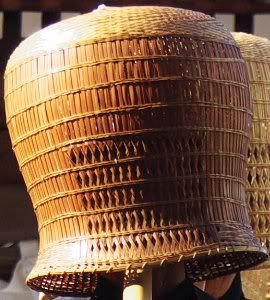
A symbol and tool, the Tengai gives wearer anonymity when playing in public and manages to interest people in shakuhachi as a powerful symbol with much history behind it. Tengai may also help to block out sun, wind, but most likely will provide little protection as is. I may create a water proof insertable "roof" for the hat for when it rains.
I wanted to make my tengai out of bamboo, however, the difficulty of getting bamboo for basket weaving is great and the price is high so it is a long term goal. I decided on rattan. I searched the net for basket weaving supplies and decided on http://basketweaving.com/shopsite_sc/store/html/index.html because their customer service and prices were very good. I have never made a basket so I ordered the "beginner" basket kit for $8. I then ordered rattan from their site which is under the link "Chair Cane & Binder Cane". For $28.95 I ordered a "Full bunch - approx. 1000 ft." of Medium 3.0mm cane which will be used for weaving the hat and 500ft of "Binder Cane, Coil" 6mm for $16.45 which will be used as the "spokes" or vertical lines. For the final bottom ring I plan to get a piece of madake which I will shave down when it is green and wrap around the bottom. Should be fun!
The Kimono, Kaku Obi, and Obi for the OKesa/Kesa
Kimono
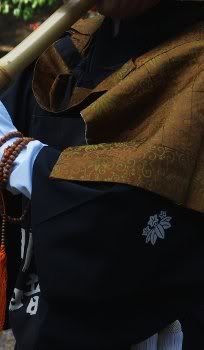
I "won" my used Kimono off ebay for $1.04 + $37 to ship from http://stores.ebay.com/antiqueryujapan
I have ordered from them before and have been pleased so I continue to give them my business. I have already acquired various women's silk Obi which my girlfriend Alana will sew into the Kesa shoulder "brocade" and some of the plain sections will be used for my obi.
Most Komuso today wear either black or white "mon" Kimono or "montsuki" Kimono. White is very hard to find on eBay. Be careful as there are "RO" or summer mon tsuki Kimono which have horizontal lines and gaps in the fabric to breath. Summer Kimono or "RO" Kimono are good for hot climates or seasons. I bought a Kimono that would go down to just above my ankle so that it would cover up my regular cloths underneath. I am not getting any under-Kimono so as to save money.
I am 180cm tall and my Kimono length is between 145cm and 150cm. I won a Kimono that is 144cm. Yukata cotton Kimono are an option as well for spring/summer and are informal as well as various jinbei which could work for hot or cold weather. Be careful not to get synthetic fiber Kimono.
Kaku obi belt and women's Obi for Okesa
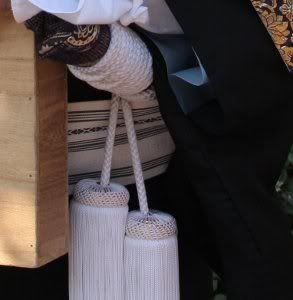
Most Komuso today use what is called a "Kaku" obi which is a stiff cotton obi belt meant for holstering swords or Katana. You most likely want to get this if you plan to holster a shakuhachi. Silk is available for men although it is rare or vintage.
For the okesa you will need women's obi. I got some with bamboo patterns to make into the okesa. I got them from the same eBay seller. Women's obi are beautiful and elaborate. Avoid "Nagoya" obi as they taper off and you do not get as much fabric to work with. Also avoid hanhaba obi as they are not very wide. Older maru obi are nice because they are double-sided.
For the ring on the Okesa I plan to use a madake root end cut off because they are free lying all around my shop and house and I often use them for charcoal.
Footwear & socks - waraji
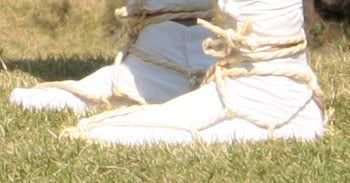
The most functional Komuso footwear are the Waraji straw sandals. I have been using a pair of "minimalist running sandals" which I made back in April 2011. I made them using vibram soling sheet which you can get on ebay. I got the 6mm thick "VIBRAM 8102 Morflex Pyramid Rubber Soling Sheet 18"x36"". They are neoprene and eventually mold to your foot. I got 1/2" elasticized leather laces from lunasandals.com. I cannot afford it right now but I plan to get "VIBRAM 8870 Newflex Rubber Soling Sheet - Shoe Repair" because it has more tread. I plan to get 8mm as this seems better for wet conditions or rocky uneven terrain which I now found myself in.
Komuso wear Tabi socks. I decided to just use regular socks but eventually I hope to have Alana make split toe wool socks for winter and I will buy some tabi when summer comes. I will just double up for now. I bought the socks a little large and mid-calf so that I can wedge the sandal strap in-between the toes. There are also very interesting Injinji toe socks but I have not tried them.
Gloves/sleeves - Teko
Komuso wear white glove like sleeve gauntlets called "teko" on mejiro.com. I could not find these. I decided that I only needed something like this in winter for warmth and plan to have Alana make them by sewing some warm material from Goodwill (second hand store).
I will be back with details on the these things as me and Alana work on them etc.
UPDATE: I finally posted a journal entry about this on my website
Intro
The Komuso is perhaps the most powerful symbol in shakuhachi. Besides the function of the clothing and tengai hat, the image of the Komuso can leave a lasting impression and help spread shakuhachi. For example a child hearing and seeing a Komuso may be a strong memory and they may grow up and decide to play shakuhachi.
The Tengai

A symbol and tool, the Tengai gives wearer anonymity when playing in public and manages to interest people in shakuhachi as a powerful symbol with much history behind it. Tengai may also help to block out sun, wind, but most likely will provide little protection as is. I may create a water proof insertable "roof" for the hat for when it rains.
I wanted to make my tengai out of bamboo, however, the difficulty of getting bamboo for basket weaving is great and the price is high so it is a long term goal. I decided on rattan. I searched the net for basket weaving supplies and decided on http://basketweaving.com/shopsite_sc/store/html/index.html because their customer service and prices were very good. I have never made a basket so I ordered the "beginner" basket kit for $8. I then ordered rattan from their site which is under the link "Chair Cane & Binder Cane". For $28.95 I ordered a "Full bunch - approx. 1000 ft." of Medium 3.0mm cane which will be used for weaving the hat and 500ft of "Binder Cane, Coil" 6mm for $16.45 which will be used as the "spokes" or vertical lines. For the final bottom ring I plan to get a piece of madake which I will shave down when it is green and wrap around the bottom. Should be fun!
The Kimono, Kaku Obi, and Obi for the OKesa/Kesa
Kimono

I "won" my used Kimono off ebay for $1.04 + $37 to ship from http://stores.ebay.com/antiqueryujapan
I have ordered from them before and have been pleased so I continue to give them my business. I have already acquired various women's silk Obi which my girlfriend Alana will sew into the Kesa shoulder "brocade" and some of the plain sections will be used for my obi.
Most Komuso today wear either black or white "mon" Kimono or "montsuki" Kimono. White is very hard to find on eBay. Be careful as there are "RO" or summer mon tsuki Kimono which have horizontal lines and gaps in the fabric to breath. Summer Kimono or "RO" Kimono are good for hot climates or seasons. I bought a Kimono that would go down to just above my ankle so that it would cover up my regular cloths underneath. I am not getting any under-Kimono so as to save money.
I am 180cm tall and my Kimono length is between 145cm and 150cm. I won a Kimono that is 144cm. Yukata cotton Kimono are an option as well for spring/summer and are informal as well as various jinbei which could work for hot or cold weather. Be careful not to get synthetic fiber Kimono.
Kaku obi belt and women's Obi for Okesa

Most Komuso today use what is called a "Kaku" obi which is a stiff cotton obi belt meant for holstering swords or Katana. You most likely want to get this if you plan to holster a shakuhachi. Silk is available for men although it is rare or vintage.
For the okesa you will need women's obi. I got some with bamboo patterns to make into the okesa. I got them from the same eBay seller. Women's obi are beautiful and elaborate. Avoid "Nagoya" obi as they taper off and you do not get as much fabric to work with. Also avoid hanhaba obi as they are not very wide. Older maru obi are nice because they are double-sided.
For the ring on the Okesa I plan to use a madake root end cut off because they are free lying all around my shop and house and I often use them for charcoal.
Footwear & socks - waraji

The most functional Komuso footwear are the Waraji straw sandals. I have been using a pair of "minimalist running sandals" which I made back in April 2011. I made them using vibram soling sheet which you can get on ebay. I got the 6mm thick "VIBRAM 8102 Morflex Pyramid Rubber Soling Sheet 18"x36"". They are neoprene and eventually mold to your foot. I got 1/2" elasticized leather laces from lunasandals.com. I cannot afford it right now but I plan to get "VIBRAM 8870 Newflex Rubber Soling Sheet - Shoe Repair" because it has more tread. I plan to get 8mm as this seems better for wet conditions or rocky uneven terrain which I now found myself in.
Komuso wear Tabi socks. I decided to just use regular socks but eventually I hope to have Alana make split toe wool socks for winter and I will buy some tabi when summer comes. I will just double up for now. I bought the socks a little large and mid-calf so that I can wedge the sandal strap in-between the toes. There are also very interesting Injinji toe socks but I have not tried them.
Gloves/sleeves - Teko
Komuso wear white glove like sleeve gauntlets called "teko" on mejiro.com. I could not find these. I decided that I only needed something like this in winter for warmth and plan to have Alana make them by sewing some warm material from Goodwill (second hand store).
I will be back with details on the these things as me and Alana work on them etc.
UPDATE: I finally posted a journal entry about this on my website
Last edited by Jon Kypros on 2024-04-01, 17:13; edited 2 times in total
So, phase: 1; Get fair trade girlfriend to do the sewing.
Not sure I would pass phase 1. If I volunteered the wife to sew me a shakuhachi super hero costume I think she might just club me over the head with the nearest 1.8.
Still, power to ya mate. Looks like an entertaining distraction.
Not sure I would pass phase 1. If I volunteered the wife to sew me a shakuhachi super hero costume I think she might just club me over the head with the nearest 1.8.
Still, power to ya mate. Looks like an entertaining distraction.
Hi Jon
Thanks for the "preview" into your great project. I am very much looking forward to read about it.
Regarding tengai and the ring. When I bought a tengai in Kyoto, the ring came unattached. So I just attached it to the hat with some strings that were made of natural material and with a colour close to the straw of the tengai. I attached it to the sides by just measuring where it would hold the tengai in the right place for me (not too deep and not too shallow) and just tying it.
In England I was given another tengai. It was a used tengai that a contemporary "komusō" had made. The ring was way too big for my head, so I put some strings inside the ring so it keeps the tengai kind of afloat. Also here the ring was just attached with strings to the tengai. So perhaps it is meant to be something that you can move according to your need.
Thanks for the "preview" into your great project. I am very much looking forward to read about it.
Regarding tengai and the ring. When I bought a tengai in Kyoto, the ring came unattached. So I just attached it to the hat with some strings that were made of natural material and with a colour close to the straw of the tengai. I attached it to the sides by just measuring where it would hold the tengai in the right place for me (not too deep and not too shallow) and just tying it.
In England I was given another tengai. It was a used tengai that a contemporary "komusō" had made. The ring was way too big for my head, so I put some strings inside the ring so it keeps the tengai kind of afloat. Also here the ring was just attached with strings to the tengai. So perhaps it is meant to be something that you can move according to your need.
What a fun project indeed!!! I'd love to wear something like that to the local Japanese Garden in Portland while playing.
James
James
Tengai
Here's the first steps of the Tengai. I decided to lay the spokes out on top of a pot, tape them down and then do two or three rounds of a basic under over weave with cotton string to secure spokes. I used 8 spokes which run from one end to the other (long) and then you have to insert your odd spoke which only runs down one end (short). Spokes will be added as needed and woven in using a twill weave which is coming up next. As long as you keep an odd number of spokes the weave will come out correctly.
Tape down each spoke as you go. Mark center of spokes ahead of time for easy and accurate placement
Soak spokes before hand
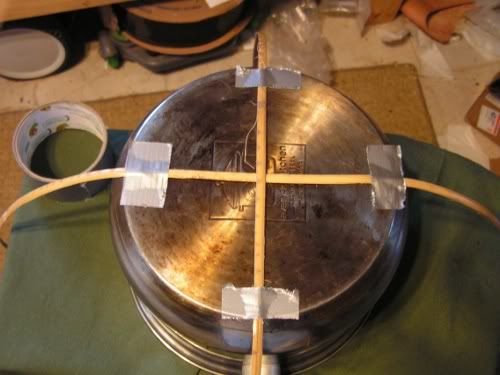
Eight spokes secured
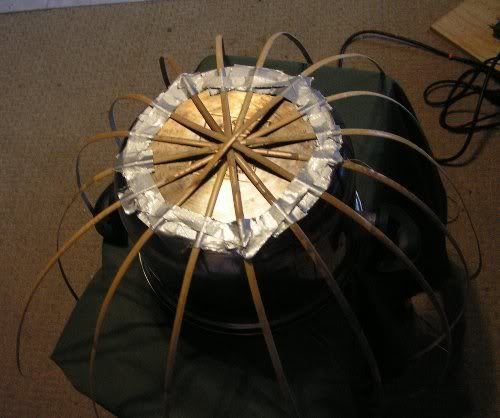
Odd spoke
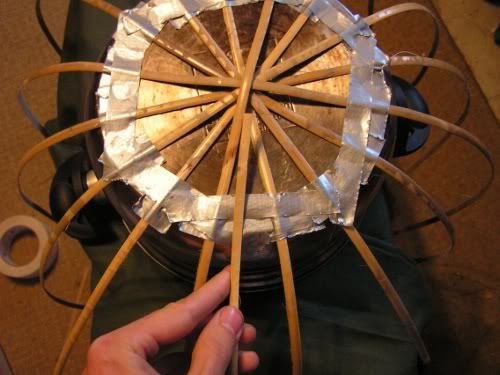
Insert odd spoke in
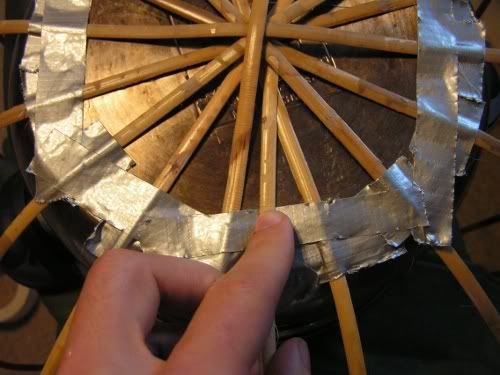
Secure with cotton string threaded in, taped end for easy threading
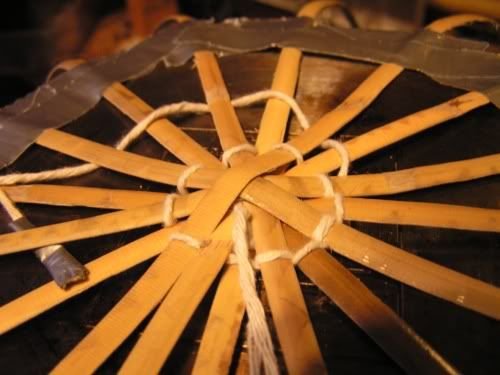
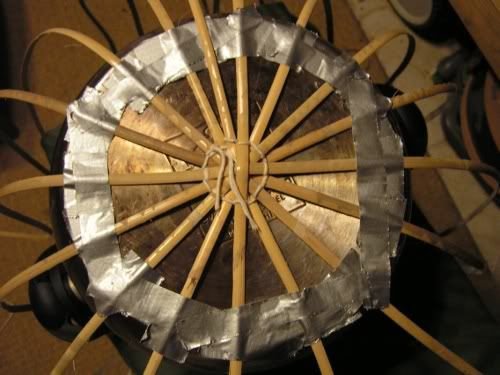
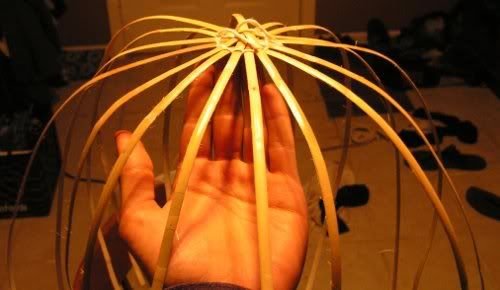
Tape down each spoke as you go. Mark center of spokes ahead of time for easy and accurate placement
Soak spokes before hand

Eight spokes secured

Odd spoke

Insert odd spoke in

Secure with cotton string threaded in, taped end for easy threading



Last edited by Jon Kypros on 2012-04-12, 05:58; edited 1 time in total
weave!
Below are photos of the hat after a few days of weaving a 2/1 twill weave. I thought I could weave it flat, however, it bowled so I pushed the top of the bowl down or rather the top of the hat down. A lot of spokes were added in along the way. The first round of 8 new spokes were locked in with a basic weave and then later I was able to thread new spokes into the twill weave. Next is the brim which will lock in many more spokes to form the body of the hat. I think I will have to double the amount of spokes in the next step.
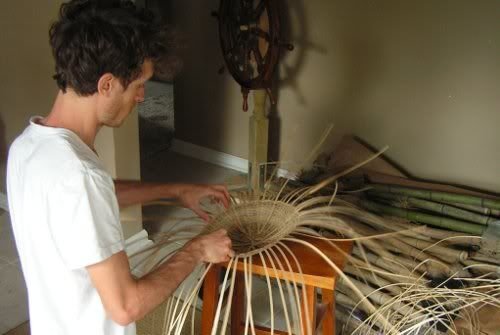

Last edited by Jon Kypros on 2012-04-12, 05:59; edited 2 times in total
taking shape
Locking in the spokes. I added a lot of spokes at the end of the weave by twining with super carriage small rattan. Next I used cotton twine to start to make the shape and I will place the permanent rattan just above the cotton string and then cut the cotton out. Actually it was just a hassle and unnecessary to use the cotton to hold it at this point.
temporary cotton string to help shape hat. Was a "waist of time"
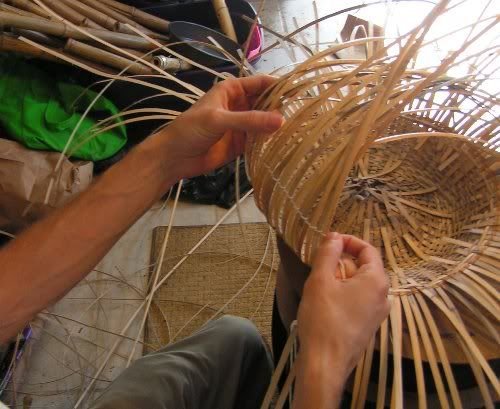
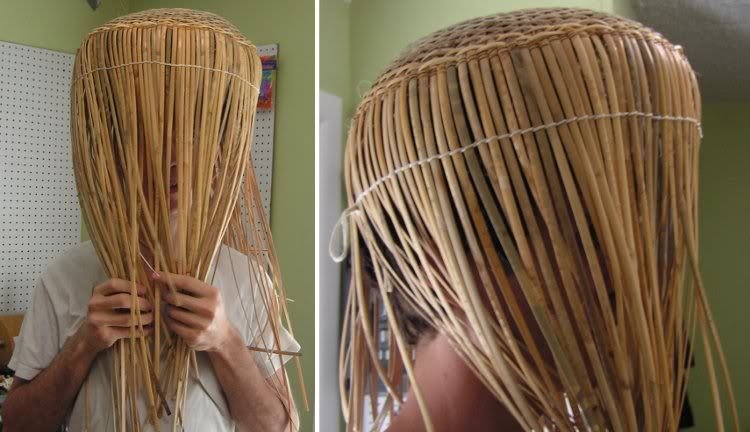
temporary cotton string to help shape hat. Was a "waist of time"



Last edited by Jon Kypros on 2012-04-12, 06:02; edited 1 time in total
Some interesting pictures...
soaking in tub
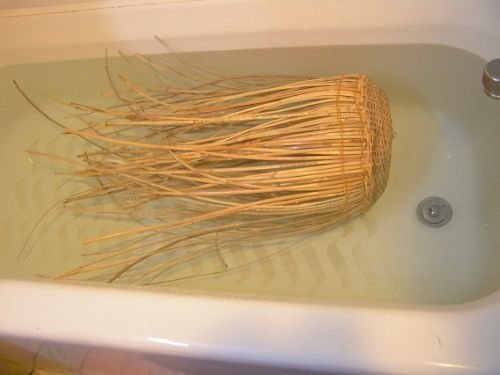
checking dimensions
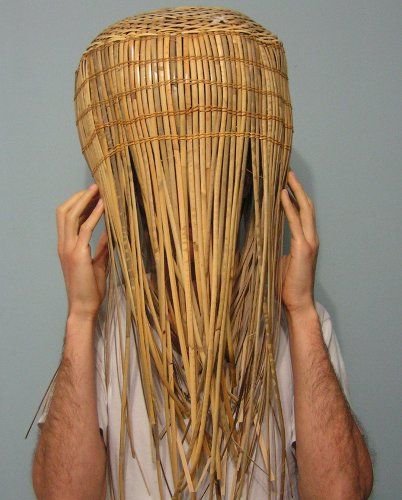
soaking in tub

checking dimensions

Last edited by Jon Kypros on 2012-04-12, 05:56; edited 1 time in total
Looks cool just like that, Jon... sort of like a komuso, Bob Marley, and "Predator" all rolled into one.
"Kiku Day""Kiku Day"This is great and very exciting to follow... and you look like a squid ! ! !


I know, it looks like a sea creature is eating my head

"Derek Choice""Derek Choice"Looks cool just like that, Jon... sort of like a komuso, Bob Marley, and "Predator" all rolled into one.
I thought of the movie Predator as well! Now if I could rig it with thermal imaging...

Last edited by Jon Kypros on 2012-04-12, 05:55; edited 1 time in total
important update
After realizing that the spokes were too large I went back to the drawing board. I'm now attempting to make the tengai using the 3mm cane as spokes. This is the cane I was using as the "weavers" in the previous hat. I will be using my "super carriage" 1.5mm cane as the weavers for this new hat. The 3mm cane actually measures out to 4mm and the super carriage on average is about 2mm so it adheres to the standard of having your weavers half the width of your spokes.
Wish me luck and "Ro on"~
Wish me luck and "Ro on"~
Last edited by Jon Kypros on 2012-04-12, 05:55; edited 1 time in total
recycle baskets
I was at Goodwill (second hand/thrift store) the other day when I noticed a lot of baskets for cheap. I thought it would be great to recycle these baskets by soaking them and undoing the weaves and then re-weaving them into a Tengai. Rattan is cheap and it may be better to just order fresh stuff. I did notice some nice baskets made with rattan that I could not find on the internet. So, good luck, Jon~
PS be back soon with updates on new tengai...
PS be back soon with updates on new tengai...
more spokes
After weaving quite a bit I decided I rather start over with more spokes then have to add spokes so I spent all afternoon arranging the spokes as seen below. I added round after round of spokes until the space between spokes was around 1/4 of an inch at 6 inches out from the center. Tomorrow I will have it secured with cotton twine.
This proved to be a mistake as it was too messy. On the next page you can see I started over with less spokes.
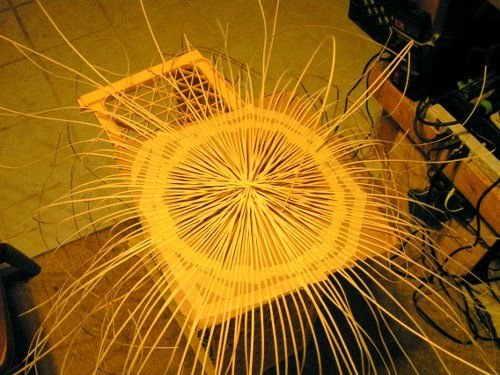
This proved to be a mistake as it was too messy. On the next page you can see I started over with less spokes.

Last edited by Jon Kypros on 2012-04-12, 06:02; edited 2 times in total
Répondre
